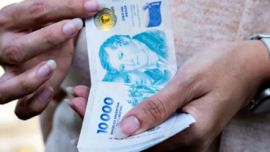Amid a summer of record heat, the most dramatic impact may be taking place under the cover of Antarctic night.
The continent at the bottom of the world normally sees a halo of sea ice grow around it each summer — or winter, if you’re in the southern hemisphere — but this year has been anything but normal. Scientists have been watching with shock as sea-ice growth stalls out in ways unseen in modern history. Sea ice, unlike ice on land, has a negligible effect on rising ocean levels. But the lack of rebound has entered territory known as “six sigma,” an obscure scientific term that denotes the extraordinary situation unfolding.
Antarctic sea ice usually reaches its nadir between February and March before regrowing over the next six or so months. This year, it hit an all-time low in February and has struggled to grow back. As of mid-July, there was an Argentina-sized chunk of ice missing, according to an analysis by the National Snow and Ice Data Center (NSIDC).
That’s a record low for this time of year in the satellite record of Antarctic sea ice, which goes back nearly 45 years. But “record low” doesn’t encapsulate it. Enter the term “six sigma.” Scientists refer to deviations from the norm in terms of sigmas, as a way to standardise data and make it easier to compare and test hypotheses.
An event that falls within the one sigma range is something pretty close to average. Reach two sigma and you’re starting to get into slightly odd territory, while three sigma events are outside the expected range of normal. The sea ice was around that level in June, according to Lettie Roach, an associate research scientist at the NASA Goddard Institute for Space Studies and Columbia University.
But something that’s a five or six sigma event is extraordinary. Researchers have pegged the odds of an austral winter like this as somewhere in the range of once in about every 7.5 million years. Some days have yielded even more eye-watering odds, though focusing on a single day alone doesn’t quite capture the big picture.
“It’s now a larger departure from average conditions than we’ve seen in the Arctic,” said Julienne Stroeve, a senior scientist at NSIDC. (Research published last year shows the Arctic is infamously heating up roughly four times faster than the rest of the planet.)
Ice is missing all around the continent, but it’s particularly pronounced near the Antarctic Peninsula and areas north of the Weddell Sea. Stroeve said conditions have been so marginal that two postdoctoral scientists she works with who are conducting research on the peninsula deployed equipment on what little ice there was, only for them to lose their gear after a storm blew through and broke up the ice.
“It’s been a very bad winter for our research there because there really hasn’t been any sea ice in that area,” said Stroeve, who also works at the University of Manitoba as a Canada 150 research chair. “It’s too soon to say for certain but all climate models have suggested the Antarctic sea ice should be shrinking in response to anthropogenic warming.”
Blistering temperatures have affected both land and sea globally, with research published Tuesday showing July’s heat in the US and southern Europe has been “virtually impossible” without climate change providing a big background boost. While scientists are still teasing out what exactly is going on around the Antarctic, climate change has taken its toll on the continent and its sea ice.
After a slow but steady growth in sea ice through the mid-2010s, there’s been a sharp step change of decreasing sea ice. The region saw record-low sea ice in 2017, only for the record to fall the next year before being toppled again in 2022 and once again this year. Natural climate shifts are partly to blame; because Antarctic ice forms around a continent rather than being contained in a basin like Arctic sea ice, it tends to be more brittle and prone to outside influences such as El Niño.
Antarctica’s land ice is also under siege from warming, as are the floating shelves of ice that act as buttresses against it melting into the ocean and raising sea levels. How all these different types of ice, atmospheric patterns and more lock together is one of the most pressing topics in science when it comes to understanding the state of the world and the role the far-off reaches of Antarctica could play in reshaping coastlines.
“I think the recent events really highlight that we have more to do to understand the drivers of these important changes we're seeing in the sea ice, ocean, land ice and atmosphere in Antarctica,” Roach said.
By Brian Kahn/Bloomberg



















Comments